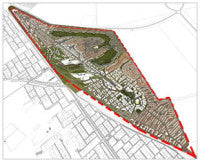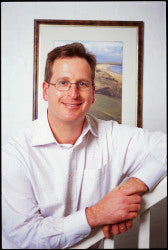Green Fingers
![AbbottsCMR07.jpg [cropped] AbbottsCMR07.jpg [cropped]](https://cdn.shopify.com/s/files/1/0582/7359/5435/files/article-content-green-fingers-AbbottsCMR07-jpg-cropped.jpg?v=1701245320) With the planet's temperature rising and worldwide concerns over 'global warming' and 'carbon footprint,' Tim Lobb, of renowned golf course architecture practice Thomson Perrett & Lobb, tells us just how green is golf? And what are course designers doing to help save the planet?
With the planet's temperature rising and worldwide concerns over 'global warming' and 'carbon footprint,' Tim Lobb, of renowned golf course architecture practice Thomson Perrett & Lobb, tells us just how green is golf? And what are course designers doing to help save the planet?
No sport is as closely linked with the land-based environment as golf, and while there has always been debate between environmentalists and golf's governing bodies over whether the sport is good for the environment, more than 1,000 new golf courses are being built every year across Europe, The Middle East and Africa, according to KPMG's Golf Benchmark Survey.
As golf course architects, we are fortunate to be able to work among nature and to have the responsibility to take a piece of land and turn it into a beautiful environment for playing golf. The months of earth moving, land shaping and turf cultivation all have an environmental impact but it's one that can be neutralised later with sound eco-management and energy efficient maintenance practices.
In the past the biggest cost to the environment has come from poorly managed golf courses, in the form of disruption to wildlife habitats, the negative impact of pesticide and chemical use, and in the vast amounts of water needed to maintain the course once it's built.
How green is golf and how do you create a sustainable golf course?
Golf is trying it's best to care for the environment, and in Golf Environment Europe, it has its own body set up to promote sustainability in golf, while the R&A, the governing body for golf outside of the United States, has its own website on sustainability and works with clubs, managers and architects to develop environmentally sound, energy efficient practices.
 A sustainable golf course is one that leaves a lasting legacy to the environment in which it's built, and is in harmony with the environmental, social and cultural needs of the area.
A sustainable golf course is one that leaves a lasting legacy to the environment in which it's built, and is in harmony with the environmental, social and cultural needs of the area.
Now, more than ever, sustainability is the hot topic in golf course design, and it's the responsibility of developers and companies like Thomson Perrett & Lobb to lead the charge and champion sustainable design practices.
Two TPL course designs in the United Arab Emirates and Turkey have been highlighted for their environmentally sensitive design and maintenance, and are a great example of what can be achieved when a designer sets out a blueprint to build a sustainable course.
At Carya Golf Club, in Turkey's Belek region, we are growing natural heather called Erica Cinerea, in glasshouses, for use on bunker tops and on mounds to give the course a classic heathland appearance, unlike any other in the region. Heather grows naturally there and it was a great opportunity to take an indigenous plant species and use it to make the golf course more beautiful and testing.
To achieve this goal, TPL built a two-hectare outdoor heather nursery to supply the club over the long term, a move that enhances the natural habitat and appearance of the golf course, and provides a sustainable means of maintaining this unique and special course.
We face an even bigger challenge to build a lush, green championship golf course in the desert at Ain Al Emarat, in Abu Dhabi, and make it sustainable and harmonious with the 120,000 people living in the nearby city at Ain Al. The golf course is going to be the centrepiece of a massive residential and leisure development, and involves sculpting a sustainable course from a xeriscape landscape of desert and waste areas.
We have already brought in several outside environmental consultants, including ecologists and sports turf maintenance specialists, and are set to use treated effluent from Ain Al's residential developments to irrigate the golf course and conserve water.
In order to make Ain Al Emarat sustainable and avoid over-using water, we designed the course to feature as much of the natural desert landscape as possible and have kept the introduction of turfed areas to a minimum. Sand dunes, moderate amounts of bunkering and large desert waste areas will be a major feature of the course and will give it a distinct, natural identity that won't require heavy maintenance.
The rich habitat corridors and wildlife zones at Ain Al Emarat have played a major part in TPL's design. Several ecologists have been consulted and the natural habitats of birds and wildlife have been preserved and enhanced by the design. Special drought tolerant grasses, including paspallum, have been selected for use and they are also tolerant to the treated effluent that will be used for irrigation.
consulted and the natural habitats of birds and wildlife have been preserved and enhanced by the design. Special drought tolerant grasses, including paspallum, have been selected for use and they are also tolerant to the treated effluent that will be used for irrigation.
It's so important to take a holistic approach to designing a golf course and to see the design role as part of a team, not designing a golf course in isolation, but interacting with the land, the local community and residential developments. For a project like this, it's a massive effort from the design team to look at the total solution and find the most sustainable way possible to build that golf course. In the end, it's an effort that's worth it, because as golfers who experience nature at its very best, we have a duty to help care for and preserve the environment.
Tim Lobb
Tim is a partner of Thomson Perrett & Lobb based in London, working with five-times British Open Champion Peter Thomson and leading Australian architect Ross Perrett. TPL have current golf course design projects underway in the United Arab Emirates, Turkey and Egypt. For more information, visit www.tpl.eu.com
